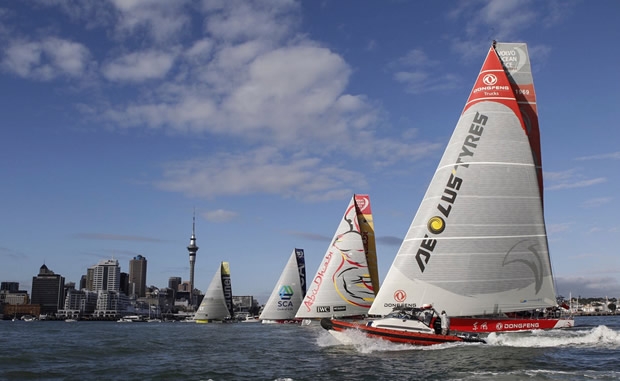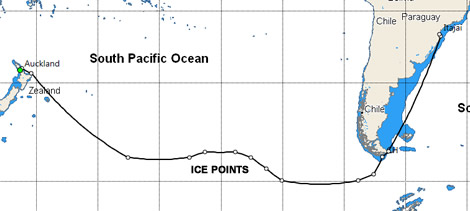
Leg five underway
After a 67 hour delay to let Cyclone Pam pass by, leg five of the Volvo Ocean Race set off from Auckland at 0900 local time (2000 Tuesday UTC).
While it was the danger of high winds and huge waves associated with the cyclone that kept the fleet at the dock on Sunday, this morning’s start was somewhat anti-climatic, in relatively flat seas and light breeze with Code Zeros as the sail of choice to sail out of the Hauraki Gulf. Dongfeng Race Team made the best of the start, held off downtown Auckland, and led the boats away from the popular New Zealand stopover on to the Volvo Ocean Race's only 'proper' Southern Ocean leg.
The postponement to avoid Cyclone Pam has led to some mixed feelings in anticipation of the leg that will see the boats round Cape Horn before heading back up the Atlantic again to Itajaí, Brazil.
Abu Dhabi Ocean Racing navigator Simon Fisher commented: “There’s nowhere else on earth where you can do so much fast downwind sailing for so long. It’s going to be the first time the whole fleet sees a lot of wind for an extended period and it might shuffle the pack. Keeping in one piece all the way to the Horn is important, because that’s where the race will be won and lost.”
Dongfeng Race Team skipper Charles Caudrelier commented: “I’m about to sail into the toughest ocean in the world with two crew members who have never sailed in more than 30 knots of wind – and only three of the crew have passed Cape Horn before [Martin Stromberg, Charles Caudrelier and Damian Foxall]. It’s added pressure and the Southern Ocean isn’t something you can explain to someone with words and hand gestures. I’m not sure they know what lies ahead and maybe it’s better that way? I trust them and they know the boat but like any Skipper I will constantly be alert. It will be difficult to relax.”
Team SCA skipper Sam Davies noted: “The most important thing is safety on this leg and to do well you have to get there in one piece, which is our objective. Playing it safe and not doing anything stupid, get round the Horn in good shape. I am most looking forward to the big waves, the long wave length in the South Pacific, to the cold conditions (which may sound stupid but after warm conditions it will be an exciting change), doing it as a team in this tight one-design race, and hoping we will go around Cape Horn in daylight so we get a good glimpse of it!”
As to the weather ahead race meteorologist, Gonzalo Infante, commented: “The conditions will be light early on, with coastal sailing up to East Cape (the tip of New Zealand), but after a few days it will be the full-on Southern Ocean regime. From then, the boats will be facing 25-35 knots for much of the time until they round Cape Horn.”
Team Alvimedica skipper Charlie Enright gave his take on the weather: “In the first 24 hours it should be pretty light and variable but still important as the boats that deal with it the best will get into the breeze first and could extend pretty quickly." But Enright said the light conditions won’t last for long as the fleet heads around New Zealand’s notorious East Cape. “The Cyclone should be stationary for a little bit which could allow us to potentially hook onto the back end of it and create some serious compression and some big breeze down there. It is actually forecast to intensify, so it will be a big factor in our routing as will the high that is trailing it across the southern Pacific.”
Cyclone Pam will no longer be a major factor for the fleet, added Infante.
For the crews the next landfall will be Cape Horn. On the great circle this is 4472 miles from Auckland, but to keep the boats away from ice, but to keep the boats away from ice they have adopted a similar system to the Barcelona World Race with a series of marks (no less than 24) which the boats must remain to the north of. If the boats follow the ice points it adds around 300 miles to the race course.

The boats are expected to arrive in Itajaí around 7 April.
Replay the start:










Latest Comments
Add a comment - Members log in